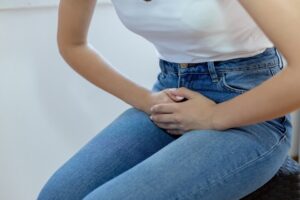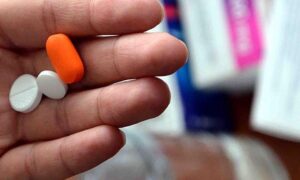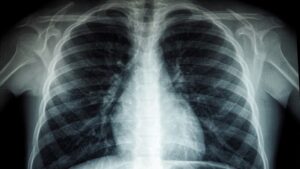[ad_1]
Menstrual bleeding is the shedding of the tissues in the inner wall of the uterus due to the weakening of the effect of progesterone in the reproductive system, together with the decrease of progesterone, one of the body’s main sex hormones, in the menstrual cycle, which is a part of the female physiology.
In some people, this process can pass a few days before the menstrual bleeding or during the bleeding period, with the complaint of cramp-like pain in the lower abdomen. to this situation painful menstruation or dysmenorrhea is named.
Since dysmenorrhea occurs recurrently in periodic menstrual bleeding, it seriously affects the quality of daily life of patients. The complaint of pain may start a few days before the bleeding and last throughout the bleeding period.
Menstrual pain can cause anxiety before the pain develops in patients, and it can lead to loss of performance in social and work life during the bleeding period. Along with the complaint of abdominal pain, patients may also have complaints such as nausea, vomiting, diarrhea, weakness and headache.
WHAT CAUSES PERIODIC PAIN?
The bleeding, called menstruation, occurs because the uterine wall, which is normally prepared for baby development, is excreted by the body as a result of lack of fertilization. The uterus is actually a muscle tissue. Here, this muscle tissue begins to contract to help shed the soft wall that surrounds its interior.
The hormone called prostaglandin triggers these contractions of the uterus. Prostaglandin reaches high levels in the blood a day or two before the onset of menstruation and begins to decrease after the first two days of menstruation. The higher the prostaglandin level, the more severe the menstrual cramps. This is the reason why menstrual pains are felt at the very beginning of menstruation. Menstrual pains felt due to the menstrual cycle are called primary dysmenorrhea. Apart from this, menstrual pains felt due to the following medical conditions are called secondary dysmenorrhea:
Cervical stenosis: In some women, the opening of the cervix is so small that it blocks the menstrual flow. This small opening can cause increased pressure inside the uterus, creating more severe pain.
Endometriosis: It is called the tissue that covers the uterus to grow and settle out of the uterus and onto the fallopian tubes, ovaries, or other tissues lining the pelvis. Chocolate can cause cysts to form, painful menstruation, as well as pain during sexual intercourse.
Uterine fibroidler: Uterine fibroids, which are composed of muscle and fibrous tissue in the wall of the uterus, are non-cancerous tumors that can be firm and large. Those with uterine fibroids may experience more severe pain during menstruation.
Adenomyozis: In this condition, the tissue lining the uterus begins to grow into the muscular walls of the uterus.
pelvic inflammatory illness: This infection of the female reproductive organs is usually caused by sexually transmitted bacteria.
WHAT ARE THE SYMPTOMS OF PERIODIC PAIN?
Menstrual pains and the different symptoms observed with these pains are as follows;
-Intense pain in the lower abdomen
This pain, which occurs a few days before menstruation, reaches the most severe points 1 day after menstruation and starts to decrease gradually after 2 to 3 days.
Pain may be felt in the legs and joints.
-Pain that gives a feeling of numbness towards the waist
-Nausea
-Intense urge to go to the toilet
-Headache
-Dizziness

WHAT IS GOOD FOR PERIODIC PAIN?
The first thing to do in the presence of any condition in the body with symptoms different from normal health organizations and their employees. In order to relieve menstrual pain, pain relievers called non-steroidal anti-inflammatory drugs can be used if the physician recommends and prescribes it.
Medical treatment Menstrual pain relief can be achieved with various methods that can be applied at home, apart from the following methods:
Putting a hot water bag on the groin or back area
Warm applications to the lower abdomen or back can be effective in relieving menstrual pain. Taking a warm bath other than a hot water bag or applying a hot towel in these areas are other methods that can be used to relieve menstrual pain.
Relaxing massage of the lower abdomen
Massaging the lower abdomen for approximately 20 minutes can contribute to relieving menstrual pain. At the same time, the duration and intensity of pain can be alleviated by the use of lavender or clary sage oil, which are classified as essential oils, while massaging.
Doing physical exercise
The endorphin chemical secreted in the body during physical activities can contribute to the alleviation of menstrual pain. Preferring light exercises such as walking or yoga instead of heavy physical exercises is considered more suitable for alleviating menstrual pain.
Consumption of nutritious but not heavy foods
The inclusion of unprocessed fiber-rich products and plant-based foods in the nutrition plans of people who complain of menstrual pain during that period may provide relief in their complaints. Chamomile tea is considered a tea that is good for menstrual pain because it has a relaxing effect on the nerves that carry the sense of pain.
Nuts, almonds and pumpkin seeds are foods rich in manganese. Manganese can contribute to the reduction of cramps that can cause pain during the menstrual period. At the same time, iron loss occurs with menstruation. In order to prevent iron deficiency, consumption of chicken, fish and green leafy vegetables is recommended.
Limiting the consumption of certain foods
Consuming less of the foods that can cause an extra bloating during menstruation can contribute to relieving menstrual pain. Fatty foods, alcohol, carbonated drinks, caffeine-containing liquids and salty foods are examples of foods that can have a relieving effect on menstrual pain if the consumption is limited.

WHO IS AT A MORE RISK OF SEVERE CYCLE?
The risk of menstrual cramps may be more severe in the following situations:
– Those younger than 30 years old,
– Those who enter puberty early, at the age of 11 or earlier,
– Those who have heavy bleeding during the menstrual period,
– Those who have irregular menstrual bleeding,
– Those who have a family history of menstrual pain,
-Smokers.
Menstrual cramps do not cause other medical complications, but can interfere with school, work, and social activities. Still, some conditions associated with menstrual cramps can have complications. For example, endometriosis can cause fertility problems. Pelvic inflammatory disease can increase the risk of a fertilized egg implanting outside the uterus (ectopic pregnancy).
WHEN SHOULD YOU SEE THE DOCTOR BECAUSE OF PERIOD?
If menstrual cramps are experienced so intensely that they affect your daily life every month, if your symptoms get progressively worse, or if you start experiencing severe menstrual cramps after 25 years of age, you should consult a specialist without delay. Misconceptions that frequent menstrual cramps can negatively affect conception are common. It is known that direct menstrual pain does not prevent conception.
WHICH MEDICINES ARE USED FOR PERIODIC PAIN?
-Nonsteroid anti-inflammatory drugs: Medicines containing ibuprofen or naproxen active substances both suppress prostaglandin levels and help relieve the feeling of pain. It can be used in the dose recommended by the doctor from the first day of menstruation. However, if you are sensitive to any of the substances in the drugs or if you have any other medical condition that interacts with these drugs, you should consult your doctor.
-Birth control drugs (Oral contraceptives): Oral birth control pills contain hormones that inhibit ovulation and reduce the severity of menstrual cramps. These hormones can also be given as an injection, a skin patch, an implant placed under the skin of the arm, or a flexible ring inserted into the vagina. In some cases, intrauterine devices may also be recommended.
Follow NTV on social media
[ad_2]
Source link






